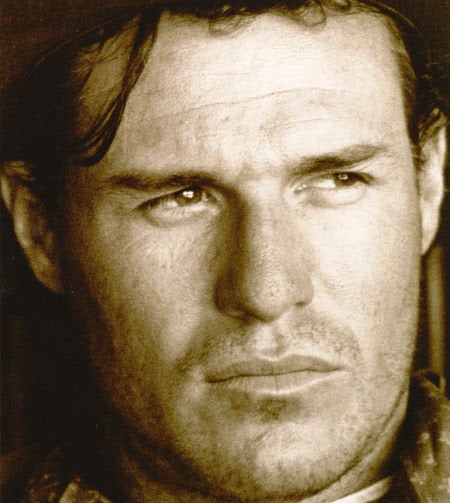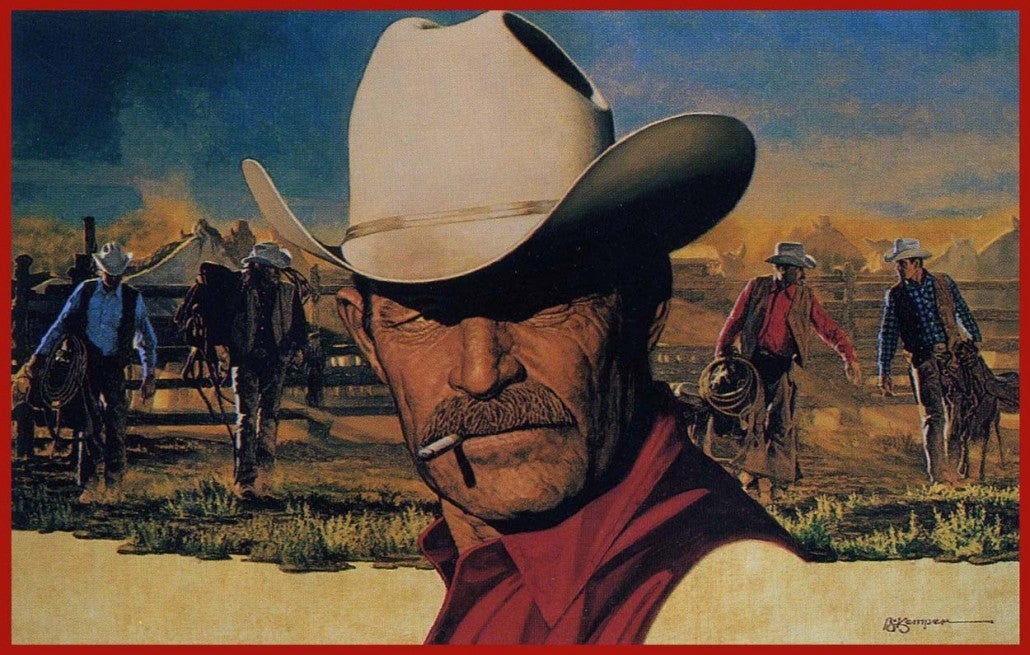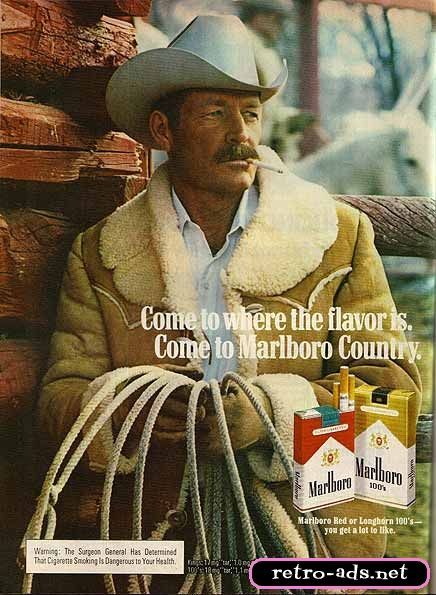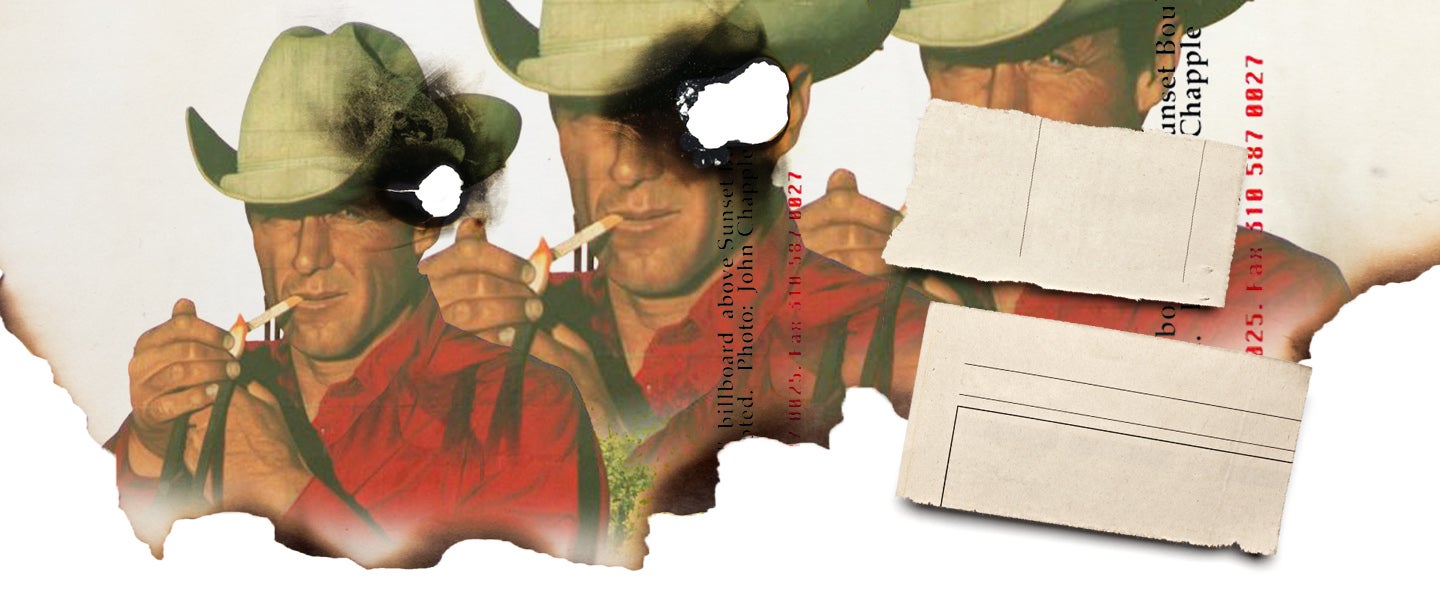“Mild as May”
That was the original advertising slogan for Marlboro cigarettes when they first hit the market in the 1920s. Decades before the rugged Marlboro Man image was born, Marlboros were a cigarette aimed at women, with their ad campaign focused around high-class ladies elegantly smoking, alongside assurances that Marlboros wouldn’t interfere with a woman’s lipstick. Later on, as cigarettes began to be sold with filters — Marlboros included — filtered cigarettes were also seen as feminine, which further caused men to shy away from the brand.
But after faltering for decades as a lady’s smoke — including trying gimmicks like dying the tips of their cigarettes red — in the 1950s, the Philip Morris Company (which owns Marlboro) decided to direct their product toward men. To overcome the idea that a filter was for a woman, the Leo Burnett advertising agency decided to attack that stigma head-on, creating a campaign where the manliest of manly dudes would be depicted smoking a Marlboro.
The result would be nothing short of extraordinary, catapulting Marlboros from less than one percent of the cigarette market to the fourth-biggest brand in under a year, eventually becoming the top cigarette brand in the world.
The ad campaign lasted nearly half a century in the U.S. and would still exist overseas for years after its American retirement in 1999. Its legacy, however, is muddled: Widely regarded as the most successful advertising campaign of all time, the beautiful imagery depicted in the ads is inextricably linked to the product it sold, which killed countless people, including several of the men who would don the iconic moniker of the Marlboro Man.

The Birth of the Marlboro Man
While the Marlboro Man ads would change little in the nearly 50 years they spent in the American landscape, the early years of the campaign didn’t focus exclusively on cowboys, opting for a variety of masculine figures smoking its cigarettes. But something about the cowboy would resonate and in time, the cowboy would become the sole image used to promote Marlboros.
Barry Vacker, professor of media studies and production at Temple University and author of The Marlboro Man as a Twentieth Century David: The original Marlboro man was this guy holding a cigarette, wearing a cowboy hat, and he’s looking not directly at the camera, but just a little bit off. That’s the very first one — they had a couple of those, and then they had this series of guys with tattoos on their hands to imply they were in the military.

Then they migrated to various images of masculinity, including various sports figures, like players for the Green Bay Packers and stuff like that. But in the early 1960s, they switched back to the cowboy and that’s when it really hit home. The ads pretty much stayed the same all the way after that.
Scott Ellsworth, former historian at the Smithsonian Institution and co-author of the Marlboro Oral History and Documentation Project: Eventually, someone at Leo Burnett noticed that whenever they showed a cowboy, there was a little rise in sales. So they decided to drop all the other tattoo guys and just go with the cowboy thing. That, of course, fit American society in the 1950s and 1960s, where Westerns were all over television with shows like Gunsmoke and Maverick and American kids were playing cowboys and Indians.
Jim Carrier, journalist and author of the Denver Post series “In Search of the Marlboro Man” (and author of an upcoming book by the same title): They eventually found a set of models that were beautiful-looking men. They had top photographers and top cinematographers, and they created this powerful imagery that appealed to something that ran deeper in the American consciousness.

Who Was the Marlboro Man?
Thanks to the disappearance of cigarette advertising, the Marlboro Man is now a symbol of yesteryear, seeming almost as dated as the cowboys of the Old West themselves. For the latter half of the 20th century, however, the Marlboro Man wasn’t just a product mascot (though he certainly was that, too) — thanks to the appropriation of the cowboy image, the Marlboro Man became something of an American hero.
Brad Johnson, ranch broker, actor and former Marlboro Man: The Marlboro Man was a fixture in American culture. For the longest time he was on the same level as 007.
Ellsworth: Class-wise, the Marlboro Man is kind of like a foreman — he’s the head of the cowboys who’s directing them to do the work. He’s not the landowner. He’s obviously a respected guy — the quiet man. He’s the guy who knows how to do things and gets them done without any fuss. He’s certainly a heroic figure. He may work for somebody else, but he’s his own man and he’s in control of his life, an independent person. The ads also harken back to a more pastoral time, where everyone isn’t punching time clocks and lining up to catch the M train with their gray flannel suits and going to work in an office.
Vacker: They were trying to create the ideal man, and there’s no bigger icon in America than the cowboy. There’s multiple meanings behind the cowboy: There’s the cowboy who’s a redneck, you know, the beer-drinking, pickup-driving urban cowboy of John Travolta fame, but then there’s the mythic cowboy, that masculine icon. He’s the lone individualist riding the range — he’s at one with nature as he’s wrangling the cows. He truly spoke to that American idea of rugged individualism.
The Marlboro Man would also come to mean different things to different people, and without ever really changing, he would be a reflection — or a repudiation — of the times. He emerged during the height of the Cold War as we’re battling the communists, who we Americans viewed at these monolithic “mass men” who all think and act the same. Here in America, there’s this rugged hero going up on billboards, which perfectly symbolized capitalist masculine Western imagery. This stoic, self-reliant figure spoke to how Americans viewed themselves and contrasted with our view of communism.
Then, in the 1960s, with all of the assassinations and the war in Vietnam, the Marlboro Man — without really changing — takes on another meaning. He suddenly represents tradition, civility and calm. When the tobacco companies agreed to stop airing commercials on television in 1970, the Marlboro Man still remained that stoic figure in magazines and billboards, not bothered by the change. In the 1980s, the Marlboro Man again takes on new meaning as the tough American, which was also in our political atmosphere with Ronald Reagan in the White House — Reagan had even starred in Westerns and had also advertised cigarettes at one time (though not Marlboros).
The Marlboro man was something of a chameleon, in that he took on multiple meanings and was always adaptable to the times — which, more than anything else, speaks to the durability of the cowboy in American culture.

The Story of a Marlboro Man
In the early days of the Marlboro Man campaign, the ad agency often turned to professional models and actors for its images, like the “original” Marlboro Man William Thourlby. But over time, the campaign decided to get more and more authentic, especially as more horse riding was utilized in its imagery. Because of this, Leo Burnett stopped seeking out models and decided to cast actual cowboys of the West by visiting rodeos and the like. One such find was Brad Johnson, who became a Marlboro Man in 1987.
Johnson: I was 21 or 22, and I was rodeoing for a living, shoeing horses for cash. I was in Reno, Nevada, at a rodeo, and I’d entered into the steer-wrestling competition. A guy came up to me and said, “We’d like to put you on tape and take some pictures of you.” Honestly, I thought the guy was flirting with me at first, but then I spoke to some other guys there who had been approached too. They said it was legit and that Marlboro had set up there and was looking for guys. It wasn’t the type of outfit where they’d go to a casting director and ask them to find some handsome guys — not at all. They’d go to a rodeo or a livestock auction and try to find guys who had the right look, but were also experienced cowboys.
Once I realized it was all legit, I agreed to have my picture taken. After that, they flew me to Wichita Falls to a little a hat maker there — they were very specific about how the hat looked. So I went there and they fitted me for a hat, then they flew me to Jackson Hole, Wyoming. That was my first shoot, which was kind of a test shoot with a famous photographer named Co Rentmeester. They wanted to see how I could ride and how I could handle a horse, which was easy because I was already doing that for a living. They took a bunch of action shots, and after that, they flew me to Carmel, California for portraits.
Next, I did a whole bunch of ads over the next four years at some pretty amazing locations. We were still doing commercials long after they were banned in the U.S., and we did an amazing shoot at Boar’s Tusk, by Rock Springs, Wyoming with Tony Scott — he directed Top Gun — and it was a big production. It was like a movie set! There were five of us Marlboro Men in front, about 50 to 60 horses and about 300 to 350 head of cattle behind them, and the chuck wagon was in the front. It was like a big pyramid; it was massive.
For another job, I remember one time we shot up at Targhee, that’s the Idaho side of the Grand Teton mountains. I was leading this horse on a ridge, and for the commercial, it had to look like this horse got spooked by a mountain lion. But we couldn’t put both animals in the same shot because it would be total chaos. They needed something to scare the horse, so they laid this tape measure on the ground, and when the horse approached, they zipped back the tape measure. That horse flipped out every time we did it, it worked perfectly.
I never did smoke — most of the Marlboro Men did, but not me. I lit a million of them, though. They taught me how to light it for the commercials and how to cup my hands perfectly. It was very specific. They had a girl with a big silver turkey platter with a pile of cigarettes. You’d put the filter on one of the teeth next to your front teeth, then clench your teeth for the strong-jawed look and look off into the distance, real stoic-ly, you know? The cigarette would burn for a second, and they’d shoot it and you’d put it out and do it again, over and over and over again.
We’d often shoot together, the other Marlboro Men and I. There was mutual respect, as all of us were the real deal and that was a must. I know they tried to use models sometimes, but for the horse stuff, there’s no faking that, so we all got along.
It was a great job and had they given me a contract, I’d still be with them. It was great pay, especially for a guy like me who was just scraping by, then suddenly bang — I was making $3,800 a day on a shoot. It was incredible. I also started doing other ads after that as well — I remember one time I had a Marlboro ad on a billboard on Sunset Boulevard, and two blocks down, I had a Calvin Klein billboard. It was crazy.
I asked them if they’d give me a contract, but it never panned out, so I didn’t want to turn down easy work. I mean, someone wants to pay you 5,000 bucks to stand there and look dumb, who wouldn’t do it? I wasn’t about to say no and go back to shoeing horses.
Eventually, I ended up having too much recognizability for what they were going for, so they stopped using me. I don’t blame them — they were using real cowboys, and they wanted to keep things authentic. So I get it. It was a great job, though, and they were great people. It was just a lot of fun.
I want to say, however, I’m not the Marlboro Man. I was one of the Marlboro Men, sure, but Darrell Winfield is the Marlboro Man — always was.

Darrell Winfield
While dozens of men would be called “The Marlboro Man” over the years, there was one man who stands above the rest, and that’s Darrell Winfield. Winfield worked for Marlboro from 1968 to 1989, and even Marlboro regarded him as “really the Marlboro man.” The ruggedly handsome, mustachioed rancher’s face would become world famous over his decades on the job, and while he certainly made more money on billboards than he ever did on a ranch, there was no question that Winfield was the real deal.

The Telegraph, “Darrell Winfield, Marlboro Man — Obituary,” excerpt: In 1968 [Leo] Burnett found Winfield, who was working as a ranch hand in Wyoming and were immediately struck by his authenticity. “I had seen cowboys,” recalled the agency’s creative director, “but I had never seen one that just really, like, he sort of scared the hell out of me.” For more than 20 years, until the late 1980s, Philip Morris and Leo Burnett carefully constructed the Marlboro campaign around Winfield’s sinewy, weather-beaten looks. At one point he was appearing in more than eight in 10 Marlboro adverts.
Carrier: Darrell Winfield was essentially a cow boss. He was one of these grunts who moved cattle at a place in Wyoming for a wealthy rancher and mucked around in cow shit, moving cattle from pasture to pasture. So when the ad people got tired of the Texas landscape, they moved to Wyoming so they could get snow-capped mountain peaks in the backgrounds of their ads. While they were in Wyoming, they discovered Winfield out there by the Wind Rivers. He looked great, and of course, he could ride, so they did some test shots of him and found that he had this appealing look. Then they hired him as one of their models.
He wasn’t a pretty boy at all. He had a mustache and kind of a grizzled face, but he was one of the truly authentic cowboys they used. He also bought a piece of property where he raised horses and rented them for Marlboro ads. But like any good Westerner, he did blacksmithing work and had a family and traded horses — the people in Wyoming knew him well. He was a very authentic guy, and I got to spend quite a lot of time with him. I think he understood clearly what he was doing. He eventually gave up smoking, as did many of the major models, and while a few of them eventually came out against smoking, not him. I think he accepted it for what it was.
The Telegraph excerpt: In an interview with the Los Angeles Times in 1975, Winfield said that Leo Burnett didn’t do “phoney baloney stuff” and claimed that the Marlboro Country image was “as close to authentic as they can make it.” Winfield didn’t wear make-up, wore his own clothes in the shoots and often provided many of the cattle and horses that appeared in the images. Asked what life might have been like if he had not become the Marlboro Man, Winfield replied that it would have been “basically the same.”
What the adverts understandably failed to mention was the toll of four (or five, according to some reports) “Marlboro Men” who have fallen victim to smoking-related diseases over the years. Despite the high death toll, Winfield remained loyal to the Philip Morris brand until his death following a “lengthy illness.”

The Deaths of the Marlboro Man
In 1999, the Marlboro Man campaign ended in America thanks to anti-smoking legislation. Twenty years later, while the Marlboro Man may evoke a sense of nostalgia for some due to its beautiful imagery of the West, for so many who have had a loved one die from smoking-related illnesses, he has a much darker legacy. Winfield’s cause of death was never disclosed to the public, but several of the other Marlboro Men officially died from lung cancer. While it’s tempting to look at the beautiful ads and artwork of the Marlboro Man and pine for a simpler time, it’s also important to remember that — while they had a significant impact upon American culture — they were still just advertisements, and they were used to sell a product that would kill millions (and is still killing people today).
The Los Angeles Times, “At Least Four Marlboro Men Have Died of Smoking-Related Diseases,” excerpt: For the longest time, the Marlboro Man was synonymous with America’s image of itself — tough, self-sufficient, hard-working. Today, the reality about the Marlboro Man is darker: At least four actors who have played him in ads have died of smoking-related diseases.
The latest was Eric Lawson, 72. “He knew the cigarettes had a hold on him,” his wife, Susan Lawson, told the Associated Press. “He knew, yet he still couldn’t stop.” She said he died of chronic obstructive pulmonary disease, which is most frequently caused by smoking. He took up the habit at age 14.
Marlboro Man David Millar of Meriden, N.H., succumbed to emphysema in 1987 at age 81. [He] had smoked for about 40 to 45 years before quitting.
Another Marlboro Man from California, David McLean, died of lung cancer at 73 in the UCLA Medical Center in 1995. His widow later sued Philip Morris, contending that McLean had to smoke pack after pack of cigarettes during Marlboro shoots so directors could create the perfect scene.
Wayne McLaren died of lung cancer in 1992 at age 51 after 25 years of smoking. His modeling job with Marlboro was followed by an anti-smoking campaign that lasted until his death. “I’ve spent the last month of my life in an incubator and I’m telling you, it’s just not worth it,” McLaren told a Los Angeles Times reporter from his deathbed in Newport Beach, where he lay with several tubes connected to his body.
After he died a week later, his mother, Louise, told The Times that some of McLaren’s last words were, “Take care of the children. Tobacco will kill you, and I am living proof of it.” McLaren had waged an anti-smoking war against Marlboro and its owner, Phillip Morris, complaining that the ads targeted kids, “the only target the companies have left.”
Carrier: Back in 1990, I had a really great job with the Denver Post, where I was called the ‘Rocky Mountain Ranger’ — I’d go on these big projects covering the major issues of the West. I decided to focus on the Marlboro Man and spent about a year locating the guys on the billboards, researching the campaign, visiting the venues where the images were shot. I did a lot of reporting on how it affected people’s attitudes about the West.
I found that the Marlboro Man ads did have an impact upon the West, as Marlboro continued to portray the American West as a land without limits — a land where you could ride a horse or drive cattle into a limitless horizon. Even well before the Marlboro Man campaign began, that was no longer a reality in the West: It had been settled; it had been fenced. The West is a place of severe limits of water and tillable land. There’s no question in my mind that many people moved West and bought a five-acre ranch with this idea that somehow they were living the dream, but it cut up a lot of land and it turned out to be property that you couldn’t raise a family on or even ranch. So I think Marlboro gave us this image of the West that didn’t serve it well.
And while I went into my project with a romantic notion, I came to realize that what Philip Morris did was hijack the image of the cowboy — an authentic American hero — and used it to pedal cigarettes, and ultimately, to pedal death.

